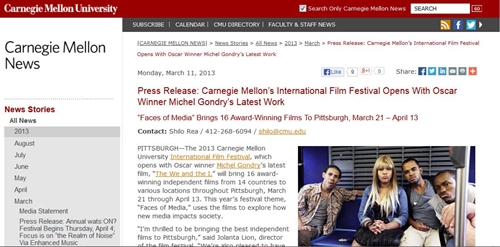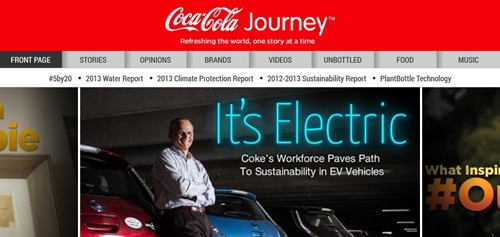 When Matt Cutts, head of Google’s web spam team, announced that links in press releases have no value for SEO, it created a lot of discussion and debate in the SEM community. But, if you look at his comments in their entirety, you’ll notice that he also said press release sites do have value for press and marketing reasons as Cheryl Conner, contributing writer at Forbes, so eloquently points out.
When Matt Cutts, head of Google’s web spam team, announced that links in press releases have no value for SEO, it created a lot of discussion and debate in the SEM community. But, if you look at his comments in their entirety, you’ll notice that he also said press release sites do have value for press and marketing reasons as Cheryl Conner, contributing writer at Forbes, so eloquently points out.
Consider,
- 92% of journalists use search engines to research stories and 81% of journalists use search engines daily (MarketingSherpa)
- Blog readership, RSS feed subscriptions and social media sites are visited in record numbers
- Journalists using Google News surpass usage of major networks, like MSNBC & CNN!
A consistent public relations program (that might include press releases) will help build general awareness of your product, service or brand and will supplement any direct marketing and advertising efforts. One good media placement, whether it’s an online blog, like Huffington Post or an online print counterpart, like Inc., can lead to a substantial increase in web traffic and sales growth potential. For many small businesses, the press release is still the most cost-effective way to get their unique angle out to local media.
TopRank has been a pioneer in the field of using press releases as an online marketing tool since 2001 when the agency was founded. In fact, there was a period of 3-4 years where TopRank provided SEO consulting to PRWeb to help them improve the search visibility of press releases being purchased by PRWeb customers.
That said, press releases have evolved from a largely media relations-based discipline to a modern profession steeped in a complex mix of stakeholder engagement, reputation management and services that blend paid, earned and owned media (i.e., advertising, PR and marketing).
Let’s not leave out the importance of the online newsroom and it’s evolution as a resource hub for today’s journalists. With the proliferation of social media, the online newsroom has become a must-have digital tool for all areas of communication, including investor relations, employee relations, marketing and brand awareness.
Press releases represent content, although the format, application and distribution have evolved. They can still reach journalists, but are also effective as direct to consumer content marketing as well.
Digital News Surpasses Radio and Television
Online and digital news consumption, meanwhile, continues to increase, with many more people now getting news on cell phones, tablets or other mobile platforms. The percentage of Americans saying they saw news or news headlines on a social networking site yesterday has doubled – from 9% to 19% – since 2010.
Among adults younger than age 30, as many saw news on a social networking site the previous day (33%) as saw any television news (34%), with just 13% having read a newspaper either in print or digital form.
While traditional news platforms have lost audience, online news consumption has been undergoing major changes as well. Nearly one-in-five Americans (17%) say they got news yesterday on a mobile device yesterday, with the vast majority of these people (78%) getting news on their cell phone. Among smartphone owners, nearly a third (31%) got news yesterday on a mobile device.
These are some of the findings in the Pew Research Center’s biennial news consumption survey, which has tracked patterns in news use for nearly two decades.
Modern Public Relations Defined
After nearly a year of research, the Public Relations Society of America (PRSA is a TopRank client) announced the winning definition of modern public relations:
“Public relations is a strategic communication process that builds mutually beneficial relationships between organizations and their publics.”
They also listed a number of reasons companies use news releases and why.
- New product announcement
- Significant modification to an existing product
- Changes in corporate identity, such as a new company name or logo
- New website
- Joint ventures
- Changes in corporate structure (New division or subsidiary)
- Corporate opinions (Opinion on industry trends)
- Features
- Events (Open houses, trade show involvement, speaking engagements, award ceremonies)
- New funding
- Personnel changes
- Corporate philanthropy (Volunteer work or donations)
- Hiring of agencies (Public relations, accounting, law firm)
- New partners
- Significant new customer
- Media advisories
- Milestones (Customers served, years in business)
- Round of funding received by the company
- Increase in market share or revenue
That’s a long list of reasons why your organization should be including news releases in your ongoing content marketing arsenal.
Pros
- Although Google discounts links coming from press release syndication, an optimized press release is still crawled by search engines and found by both consumers and journalists.
- Multimedia news releases allow you to deliver your news in a multimedia format blending video, audio, text, logos, photos and related documents to help expand the reach of your news.
- A digital press release can be distributed much more quickly than emailing relevant trade press and reaches a larger audience through online syndication.
- A press release is more cost effective than traditional advertising to get the word out.
- You benefit from the amplification effect by embedding social media links, extending both the reach and life of your releases online.
Cons
- Creating a regular calendar of relevant news may tax your internal resources; alternatively, hiring professional writers who can provide a fresh take on a news story may be outside your budget.
- Press releases are hard to measure ROI; generating a lot of referral traffic may not lead to sales.
- While press releases are less expensive than paid advertising, when counting number of man-hours or consulting fees, they are not necessarily cheap.
- If you don’t have the resources to push your release out through social media and bloggers, mainstream media or trade organizations, press releases by themselves, won’t improve your communication with your target audiences.
- Competition for distribution is high; there is no guarantee your release will be successful.
What the Experts Are Saying
“Before the rise of social media, public relations were about trying to manage the message an entity was sharing with its different audiences. Now, P.R. has to be more about facilitating the ongoing conversation in an always-on world.” Adam Lavelle, a member of the board of the Word of Mouth Marketing Association who is the chief strategic officer at the iCrossing unit of Hearst.
“In a world where the ordinary consumer is walking around with global publishing power in his or her pocket, the role of public relations and corporate communications has shifted from creating content to attempting to influence the content that’s created by others.” Dan Tisch, chairman of the Global Alliance for Public Relations and Communication Management, chief executive at Argyle Communications
Press Release Examples
Carnegie Mellon
This 113-year old Pittsburgh institution of higher learning isn’t resting on its reputation alone to get the word out. Carnegie Mellon is in the news nearly 365 days a year. From ground-breaking research to award-winning faculty, the university prides itself on an interdisciplinary philosophy. To that end, below is a press release for their College of Fine Arts, promoting an International Film Festival.

What Carnegie Mellon is Doing Right:
- Topic optimized headline which helps with branding and search visibility
- Excellent use of hyperlinks to provide a scented trail of additional information for media and attendees
- Prominent display of a number of social sharing buttons, increasing amplification potential
- Effective layout, color and use of photography
Coca-Cola
Here’s an example of a brand demonstrating the characteristics of the real-time, data-driven newsroom — a model that’s prolific, agile and audience-centric and takes the online newsroom one step further with its brand journalism website.

What Coca-Cola is Doing Right:
- Visually creative layout consistent with brand messaging
- Provides a centralized, social-media-equipped online information headquarters for mainstream journalists and consumer
- Offers a digital tool for all areas of communication, including investor relations, employee relations, marketing and brand awareness
- Coca-Cola has invested heavily in social business and it shows. With seven of the most popular social networks prominently featured in the footer, along with follower numbers, making it easy for users to engage everywhere.
Content Marketing With Press Releases Best Practices
- Write a catchy, interesting and keyword- focused headline.
- Make the intro/opening engaging.
- Write in laymen’s language. Avoid superlatives, jargon and excessive mentions of a brand name.
- Make the release useable, word for word, if cut after the second paragraph.
- Keep most paragraphs to below 30 words and the length no more than 650 words max.
- Spell check and then read your news release aloud. Any typos or grammatical errors will ultimately lead to your news being discarded and can tarnish your reputation.
- Repress the urge to use fancy fonts, colors, font styles and other text attributes in your news release. You’ll come off as an amateur.
- Include relevant links for background information. Make it easy for journalists and news consumers to conduct further research.
- Make it easy to share; include all your social networks.
- Send only news releases that contain news!
Press releases represent a great way to engage in inbound marketing. No longer do you have to rely on a constantly churning media list to secure coverage and visibility. Today, your press release has thousands of opportunities to make a lasting impression online.
Are you still using press releases as part of your media relations or online marketing mix? Do you use press release distribution services or do you send them directly to your media contacts list?
To check out more of our content marketing tactics articles, please be sure to visit the index.
Photo credit: Shutterstock


